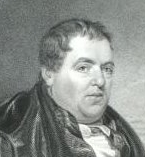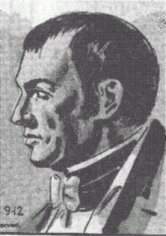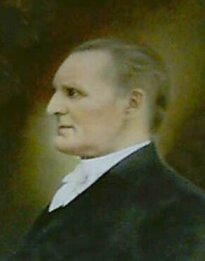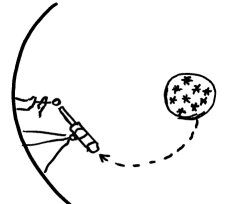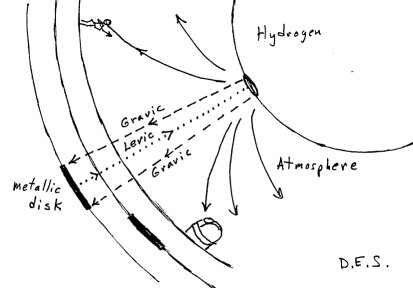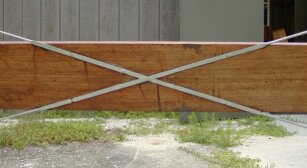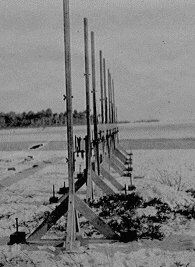|
Certain incidents in history of science, even recent ones, have been forgotten, swept under the rug of history. Historians of science focus on some of those that were crucial turning points of scientific advance, such as the Ptolemaic planetary system, phlogiston and caloric, and the luminiferous ether. Others are ignored even by historians. Flat earth and hollow earth theories have suffered that neglect. Information about these is fragmentary, frustratingly incomplete, and in danger of being lost through neglect and decay of original source materials.
We are dealing here with ideas well out of the mainstream of the scientific developments that led to today's science—the science found in textbooks. But non-mainstream ideas also have continuity, evolution and development. Some of these have great appeal to a certain sort of mind. Few ever completely die, but reappear in modified form. We will look at one such idea, the Cellular Cosmogony of Cyrus Reed Teed, which arose in the late 19th century, and still has adherents today. It envisions a universe that is an inside-out version of conventional cosmology, a universe with the earth outside, and everything else inside. At first look this seems so incredibly original that it couldn't have arisen from earlier ideas. Even more incredible is the fact that Teed asked his associate Ulysses Morrow to find experimental proof of the earth's concavity. Morrow did the experiment and found the result they sought. How could this happen?
Old and discredited ideas, like zombies, don't stay dead. They arise in new forms every so often. If one judges by internet web sites, we are experiencing a revival of hollow earth wackiness. Many persons are promoting such notions, but it's hard to judge how many actually believe them. Some web sites promoting the idea have the flavor of cleverly contrived parody or satire. What's new is that these sites expand on the hollow earth hypothesis by citing the "evidence" of misinterpreted photos from NASA's space probes. These sites are characterized by cherry-picking of "evidence", clever rewording of sources to suggest interpretations the sources never intended, total lack of quantitative analysis, misunderstanding of physics (especially centrifugal forces and gravity), or deliberate rewriting of physics to suit preconceived ideas.Some have thought that in this (and other) web pages I am promoting the hollow earth idea. That's a complete misunderstanding of my purpose. The hollow earth hypotheses (both kinds), and the flat earth hypothesis are not supported by evidence, and are at odds with abundant reliable evidence against them. Some argue that it's all a matter of point of view, and that by a suitable warping of our ideas about space, these "alternative models" can be sustained. That's simplistic, for though one can warp geometry to accommodate a geocentric universe, an inverse universe (the inside-out hollow earth with the universe inside it) and many other morphed metrics, that's only part of the picture. You'd then have to rewrite all of physics as well to accommodate what we observe. Newton's laws, Maxwell's laws, relativity and everything else in standard physics texts would take on totally new forms. None of the purveyors of perverted geometry have done this, for they are ignorant of the totality and unity of physical laws, and haven't the ability to do the job. Their self-proclaimed cosmic insights are only a superficial and trivial "cleverness".
Hollow earth
Never mind what they taught you in geology courses about the inner structure of the earth. Nobody has gone inside to see what's there, have they?
During the 17th century scientists were seriously investigating the problem of determining the true shape of the earth and understanding the global variations in magnetic dip angle. As often happens, imaginative speculations arose far sooner than did understanding of the data.
 |
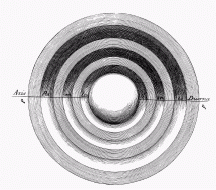 |
 |
| Edmund Halley (1656-1742) | Halley's Hollow earth From his 1681 paper. |
Halley at age 80. He's holding a drawing of his hollow earth. |
|---|
In 1692 astronomer Edmund Halley (of Halley's comet fame) published a paper titled An account of the cause of the change of the variation of the magnetical needle with an hypothesis of the structure of the internal parts of the earth: as it was proposed to the Royal Society in one of their later meetings. (Philosophical Transactions of the Royal Society of London 17:563-578).
Halley postulated that the earth we walk on is a hollow shell about 500 miles thick, with two inner concentric shells and an innermost core, about the diameters of the planets Venus, Mars, and Mercury. These shells are separated by atmospheres, and each has its own magnetic poles. The spheres rotate at different speeds, thus accounting for long-term magnetic field variations. Halley did wonder whether clay and chalk beds of the outer crust are sufficient to prevent the oceans from leaking inside, but he was sure that "the Wisdom of the Creator has provided" some way to prevent this.
Halley even suggested that each sphere "might support life," because the spheres were bathed in perpetual light from a luminous gaseous atmosphere that filled all of the inner spaces. He even entertained the possibility of "more ample creation" within the earth, which might include suns.
When the Royal Society asked Halley to explain the exceptional auroral display of 1692, Halley wrote that it was caused by light from inside the earth. Newton's demonstration of the oblateness of the earth led Halley to suppose the earth's outer shell was thinner at the poles, allowing inner light to diffuse out, then scatter from the atmosphere, causing auroral displays.
|
Some books and websites say that the Swiss mathematician Leonhard Euler (1707-1783) proposed a simpler hollow earth model. Some give details, but few provide a reference. One that does cites: Euler, Leonhard; Letters of Euler on Natural Philosophy, Vol 2, Letter LVIII, pp 202-203, 1835. That does not seem to be correct. However, in Volume I, letters XLIX and L of Euler's Lettres à un Princess d'Allemagne we find his comments on an interesting mathematical problem often found in textbooks today: If you drilled a hole all the way through the earth, and dropped a stone in the hole, what would happen? It's a "thought experiment" and someone may have misread Euler, supposing that Euler really thought there was hole all the way through the earth. Then others picked it up without checking sources. You can find my discussion of this problem at Physics Problems to Challenge Insight, and a detailed discussion of what Euler had to say about it at Ed Sandifer's website. Prof. Duane Griffen of Bucknell University has researched the hollow earth idea and Euler's views about it:
In Letter XLIX, concerning the "True Direction and Action of Gravity relatively [sic] to the earth," he introduces a thought experiment, stating "were you to dig a hole in the earth, at whatever place, and continue your labor incessantly [...] you would, at length, reach the center of the earth" (Vol. 1, 219). Moreover, in Letters LVI-LIX, concerning magnetic declination, he discusses Halley's proposal at length. Concerning Halley's "double loadstone in the bowels of the earth" and four magnetic poles, he states: "this hypothesis seems to me rather a bold conjecture" (Vol. 2, 253).
Some sources even say that in 1767 Euler proposed that the earth's hollow interior contained at its center a small glowing core that served as a miniature sun for the inner world's hypothetical inhabitants. I can find no documentation to link this idea with Euler, and I doubt it has any connection to Euler.
|
Sir John Leslie (1766-1832), a Scottish physicist and mathematician, known for his studies of heat, proposed a hollow earth in his 1829 Elements of Natural Philosophy (pp. 449-453). Some have claimed it was Leslie who suggested that the hollow interior of the earth contained "two little suns", Pluto and Prosperina (the "planet" Pluto hadn't been discovered and named then), but that idea may have originated with someone else. Jules Verne's classic tale Journey to the Centre of the earth (1864) was probably partly inspired by these ideas.
We see here several ideas: (1) An earth shell structure, with spaces between the shells. (2) Suns within the earth. (3) Civilizations living on these shells. Yet we are still in the dark about when and where these originated, and who was responsible. Today's supporters seem desperate to link them with reputable scientists, but some of those attempts fail.
 |
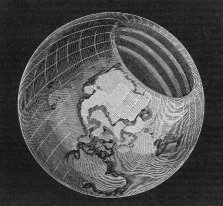 |
| John Cleves Symmes (1780-1829). |
Symmes' hollow earth. |
|---|
An American, John Cleves Symmes (1780-1829) absorbed such ideas and brought forth his own version. His hollow earth had holes at the North and South Poles. Symmes proposed an expedition to find the North Polar hole and enter it, fully expecting to find animals and people inside the earth, living on five internal shells.
Of course he was ridiculed by those less imaginative than he. People made cruel jokes about the "Symmes Hole" or the "Symmie Hole" at the pole, suggesting that the hole was in Symmes' head.
|
A profound misunderstanding of gravity is present in all of these models, for they allowed the inside dwellers to live on either the outer or inner surface of each shell. Symmes assumed that a person could walk on the inside of the shell, feet away from the center, head toward the center, with the inner sun always directly overhead. He supposed that a ship sailing to the North Polar hole would simply sail around the rim of the hole and end up sailing on the ocean on the inside of the same shell, with its masts pointing toward the center. Inflamed with the possibilities of sailing inside he petitioned the U. S. Congress (in 1822 and 1823) to appropriate money for a Polar expedition. He was turned down (in one of the few instances where Congress showed good judgment in spite of not understanding the issue). Late in his life he attempted to join a Russian Polar expedition, but could not raise the fare to the departure port of St. Petersburg. That's too bad. His theory was already popular in Russia.
John Symmes died in 1829. His grave was the closest he got to the inside of the earth. John's son, Americus Symmes, had a monument erected over the grave, with a hollow earth model at its top. Restored in 1991, this monument still stands in the center of fourth street park in Hamilton, Ohio, just South of the business district.
Readers today may be surprised to learn that in the 19th century a variety of views about the shape of the earth still existed and competed. Zetetic (flat-earth) societies, formed in the 18th century, were still flourishing in the 19th century. Flat earth organizations actively argued their case and even supported experiments to prove their point. The famous Old Bedford Canal experiment of 1870 tested the "flatness" of the water over a four mile straight stretch of the Bedford Canal. [5] The flat earthers proudly proclaimed that the result confirmed their assertion of the flatness of still water surfaces (and the entire earth). Alexander Gleason, a civil engineer from Buffalo, NY, experimentally established the flatness of the surface of Lake Erie, at least to his own satisfaction. He published his results in Is the Bible from Heaven (1890) and Is the earth a Globe? (1893).
In the last decades of the 19th century diverse models of the earth and heavens were actively promoted. Isaac Newton Vail proposed an annular theory to account for the formation of the earth and planets, but assumed a convex earth. The Gillespian theory put the earth and sun in fixed positions, allowing the earth to rotate. A "conic" theory modeled the shape of the earth as something like a cone, its base being the North polar region, and its apex at the South pole. There was even a small publication titled The Square World promoting an earth shaped as an inverted soup bowl, the Northern hemisphere being about as we know it, but with the Southern Hemisphere flaring out to a larger rim. It's a mystery why the author describes it as "square", but it has something to do with the Biblical reference to "the four corners of the earth". {1}
|
Not everyone accepted the results of the experiments intended to determine the shape of the surface of water. Some thought the earth's surface was convex (the view most folks accept today), and still others thought it concave (like the inside of a bowl).
Cyrus Reed Teed (1839-1908) was an alchemist from Utica NY, practicing "eclectic medicine" in the 1860s. His alchemy experiments convinced him that the universe was all of one substance. Shortly after, in 1869, he received a spiritual "illumination" from "The Divine Motherhood", who told him the nature of the universe and everything. This confirmed Teed's suspicion that the conventional view of the earth within the universe was wrong—that the earth was actually outside and all the rest was within. She told him to redeem the human race and carry on the work of Jesus as a "New Messiah." Part of his task was to unify science and religion.
Flat earth and hollow earth ideas are almost always associated with religious convictions, and their proponents have always been able to cite Biblical foundations for their ideas, whichever model they promote. On an emotional level, many people are uncomfortable with the vast and unimaginable size of the universe as described by conventional science. They prefer a smaller cosmos, with everything nearby. What possible use could the creator have for all that stuff so far away from us? How wasteful to create all that vastness just for us to admire on a starry night.
The flat-earthers earth was a round flat pancake with a sun only 2000 miles away and only 32 miles in diameter. To account for variation of the angle of incidence of sunlight on the earth's surface, they had to assume severe bending of the path of light rays.
Somehow many of these ideas converged into Teed's Cellular Cosmogony.
The Cellular Cosmogony.
Out of this came Teed's model of the universe—an inside-out universe. It was described in his 1898 book, The Cellular Cosmogony. [2, 3]
 |
| Cyrus Reed Teed's Cellular Cosmogony. |
|---|
Teed's universe occupies a "Hollow cell" in solid rock, 8000 miles in diameter. We live and walk on the spherical inner surface of this cell, our heads pointing toward its center. The entire universe that we "see in the sky" lies within this cell, cradled "in the hands of God." Inside this earth-shell there are three atmosphere shells: air, hydrogen, and aboron.
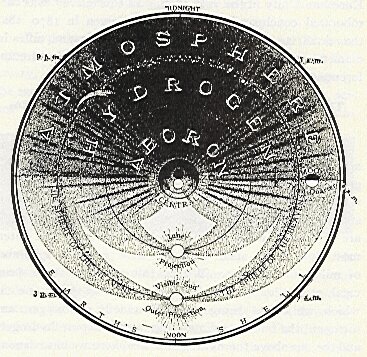 |
| The cause of day and night. |
|---|
At the center is the sun, an invisible electro-magnetic battery in the form of a helix, rotating on a 24 hour cycle. It also has a precessional movement of 24,000 years, accounting for the precession of the equinoxes. (Teed certainly tries to make this a model capable of explaining everything.) With the sun at the center, it is one of the few cosmological models that is both heliocentric and geocentric! [The other is the Gillespian theory.]
|
We do not see the sun directly; its rays bend by refraction and "focalize" twice. We see the second focalization at the top of our atmosphere.
In this universe, light rays take curved paths to reach the earth. Such paths are clearly required to agree with the observed apparent differences in position of the sun in the sky at different places on earth.
The sun is half dark, half light, and its rotation gives the illusion of sunrises and sunsets, night and day and seasonal variations in the apparent position of the sun. The back, or "dark" side, of the sun emits light from many points at which energy is generated. These focalize and are seen as the stars.
Due to turbulence and aberrations in the atmospheres the focalizations of light are sometimes imperfect or blurred. These appear as nebulae. Comets are reflections of the sun's rays through lenticular reflections and refractions from belts of tiny crystals around the central solar sphere. The sun is like a huge eye, with an iris. The iris is visible only when the atmosphere has refractive prismatic influences. Then we see the sun's iris as a rainbow.
|
Describing this model is made difficult because words such as "inner" and "outer", and "under" and "above" have meanings opposite to what we are used to. The planets are disks floating between the metallic layers of the earth's crust (in the rock shell that we walk upon). This part of the earth shell is only 100 miles thick and has 17 layers. The outermost (greatest radius) 7 shells are metallic, the gold layer having the greatest radius. The next 5 are mineral. The next five are geologic strata. Teed's background in alchemy certainly influenced this part of his model.
The moon, planets, and stars that we think we see in the sky are illusions within the hollow cell within the rock shell. We can't see to the other side of the hollow earth's surface, because of the intervening dense atmospheres. Gravic rays emanate outward from the sun, holding us onto the earth crust and accounting for effects heretofore attributed to gravity. (Take that, Newton!) Levic rays, something like X rays, are produced when Gravic rays reflect from the metallic mirror-like planet disks. Levic rays project toward the center, onto the hydrogen sphere, and unite with gravic rays to produce light. This light travels outward, focalizing several times, forming a final focalization at the top of our atmosphere that is a virtual image, which we see as the planet. But it is only an illusion. Gravic and Levic rays apparently don't refract much, but light refracts a lot in Teed's cosmology.
The moon is also a focalization of this kind, but it is an image of the entire earth's crust. The features we see on the moon are something like an X-ray of all the geologic strata in the crust of the earth.
Quantum mechanics is much simpler to explain! Much of the detail of Teed's explanations of his model seems motivated by critics, who insisted he account for the daily, seasonal and long-term variations of the position of the sun. Much less attention was paid to other questions not asked. For example, if the stars are focalizations of sunlight formed in the gaseous atmospheres, then why are the star's apparent positions so stable with respect to each other? They are so stable that we can describe their patterns as constellations and make maps of them. Yet the sun's position with respect to the stars changes by large amounts throughout the year.
We see in Teed's Cosmogony a melding of many ideas of earlier origin. His universe had an earth shell with sun inside, and we live on the inside of this shell. This is much like Euler's hollow earth idea. The extreme curvature or refraction of light is much like that assumed by the flat-earthers, and served the same purpose: to make astronomical observations fit the model.
Such a model of the universe would seem to be so bizarre that it could only have arisen once. But apparently others claimed to have had similar revelations. Consider the 1882 pamphlet by G. L. Burnside, titled Extraordinary Revelations. Burnside (a spiritualist medium) had a revelation, during a seance in 1856, of the true geometry of the earth and the universe. It is a universe in which the earth has shells within, some possibly inhabited. The earth is surrounded by a hollow shell of rock, but the planets, sun and stars are all illusory images moving on this shell surface, like lantern-slide projections on a screen. Burnside mentions that J. Thomas of England promoted a similar model. This is rare. Proponents of such eccentric views seldom credited others.
And in 1871 a book appeared by Prof. Wm. F. Lyon titled The Hollow Globe; or The World's Agitator and Reconciler. It describes scientific information given to him over several months in 1868 from M. L. Sherman, who was getting it from the spirit world in bits and pieces.
So who was first with this eccentric idea? Burnside says he got the idea in a seance in 1856, though his book appeared in 1882. He acknowledges that J. Thomas had similar ideas earlier. Lyon's indirect communication with the spirit world was in 1868. Teed says his "illumination" came from the female half of the Godhead, the "Divine Motherhood" in 1869. Who knows what earlier roots this idea had that we simply haven't stumbled upon yet?
We see in these models elements similar to those of Teed's model, but Teed's inside-out inversion of the earth and cosmos was probably the most fully developed (though nearly incomprehensible) version. Earlier hollow earth models of Halley and Symmes had the possibility of people walking inside the earth shell, with sources of light and heat also inside. Teed put us inside, along with the sun, moon, planets, and everything else in the universe.
Put it to experimental test.
|
Teed established the Koreshan Unity, a small communal society that taught the importance of celibacy, and of a correct understanding of the shape of the earth and universe—Teed's "Cellular Cosmogony". Teed adopted the name "Koresh", the Hebrew version of his given name "Cyrus", and the society was known as the Koreshan Unity. The Koreshans established a communal home in Chicago in 1886.
Ulysses Grant Morrow, a newspaper editor, writer, poet, inventor, and geodesist, held views of cosmogony similar to Teed's, and Morrow joined the Koreshan Unity in Chicago. Teed wanted "scientific proof" of the shape of the earth, preferably experimental proof. Morrow took on the task of supplying it.
On July 25, 1896 Morrow made observations on the Old Illinois Drainage Canal, sighting a target 18 inches above the water surface and 5 miles away, with a telescope elevated 12 inches above the water. According to accepted values of earth curvature, the target should have been over 9 feet below the line of vision, but it was clearly visible in the telescope. Morrow considered this "the most unmistakable evidence of the water's non-convexity."
Morrow made similar sightings on August 16, 1896 from the shore of Lake Michigan at the World's Fair Grounds. Sloop yachts were sighted at 12 miles from shore, from a pier 10 feet above the water. With low power opera glasses, the sails and masts were clearly visible, but the hulls were below the visible water surface. With a 50 power telescope the hulls were clearly visible. Sightings were also made with the telescope 30 inches above the water. According to conventionally accepted curvature of water, the hulls of the boats would have been 60 feet below the surface. Seven other sightings were made from Roby, Illinois on Aug 23, 1896, with similar results.
These experiments were easily dismissed by critics as simply due to atmospheric refraction. Morrow sought a more convincing method for measuring water surfaces, one that would not use light.
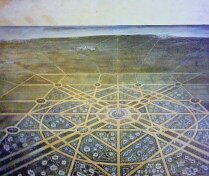 |
 |
| Teed's plans for a "New Jerusalem". The Koreshan Historic Site. |
Illusions of light. |
|---|
In 1894 the Koreshans moved to 300 acres of land in Southern Lee County, Florida to found their visionary "New Jerusalem" settlement. Morrow moved there with them. At this time Morrow and Teed were both engaged in trying to muster evidence for the Cellular Cosmogony, partly to convince critics. Thus was born the famous "Naples experiment".
Previous experiments had convinced Morrow and Teed that views of distant objects are partly due to an "illusion of perspective". They sought a method for measuring the earth's curvature that would not be subject to such "errors". Morrow conceived such a method—to establish a physical straight line to compare with a water surface. He imagined a number of perfect and rigid solid rectangles placed end to end to establish a perfectly straight row, and therefore constitute a perfectly straight reference line, independent of telescope or visual sighting methods.
The Koreshan Geodetic Survey of 1897.
Morrow refined the notion of solid rectangles with something more practical. He replaced each rectangle with a "rectilineator" of his own invention. It was a wooden structure 12 feet long, 4 feet wide, made of 19 year old seasoned mahogany. Steel bars provided cross-bracing between brass fittings at each corner. These brass parts were precisely made to allow each rectilineator section to be aligned precisely with its neighbors, then bolted together firmly. At least 4 sections were made, by the Pullman Railroad Car Company. Only section No. 2 survives.
Near Naples, Florida is a four mile north-south stretch of nearly straight beach—ideal for the experiment. At this time Florida was still a "frontier", sparsely settled with large areas of virtually untouched wilderness teeming with alligators, snakes and many biting insects. The summers were hot and humid. It is much the same today, except that it also has beach houses, condominiums, malls and tourists.
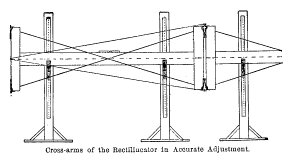 |
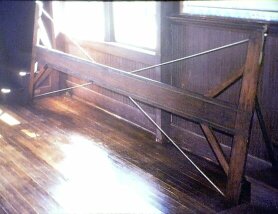 |
| Morrow's drawing of the rectilineator. | Morrow's rectilineator. The only surviving section at the Koreshan Historic Site. |
|---|
The rectilineator sections were each supported by two "standards"—vertical beams resting on "footpads" anchored on the beach. The first rectilineator section was carefully leveled, using a 12 foot long mercury level designed by Morrow, a standard calibrated spirit level, and a 4 foot plumb bob that could be placed at each end of a rectilineator section. The next section was aligned approximately with the first, then precisely positioned until the facing brass surfaces would just allow insertion of a celluloid card at each corner. When all was perfect, the sections were bolted together, and the process repeated. After all of the available 12 foot sections were in place, the first one was carefully removed, inverted top/bottom and relocated at the other end of the line, to compensate (average out) errors due to any slight initial error in parallelism of the cross beams.
Data were recorded each 1/8 mile. But every 12 feet the vertical distance between a reference mark on the rectilineator and the mean water level was noted. [Very likely the spirit levels and the plumb line were checked also, each time a 12 foot rectilinear section was put into place.] If the earth were convex, this distance should increase as the land line progressed southward. If the earth were flat, the distance should remain constant. If the earth were concave the vertical distance should decrease with the horizontal distance southward. Moreover, for a convex earth, the vertical distance should change slowly at first, then more rapidly as the line progressed southward.
The measurements of mean water level would seem to be a weak point of the experiment. The rectilineator line was on the beach. The water level needed to be determined in the water. This was done with caissons in the water. These damped out fluctuations due to waves sufficiently that a very accurate determination of a steady water level could be made. These were of course corrected for the continual tidal variations during the day and over many days. The water level at the caisson was "transferred" to the land line by telescopic sightings over the relatively short distance from beach to caisson. Over these distances, error due to light ray curvature was considered negligible, and these sightings were perpendicular to the 4 mile N/S land line. Besides, any such curvature error should be the same for every measurement, and would not affect the results. One caisson remained in place at the starting point, and changes in the water level there were continually monitored.
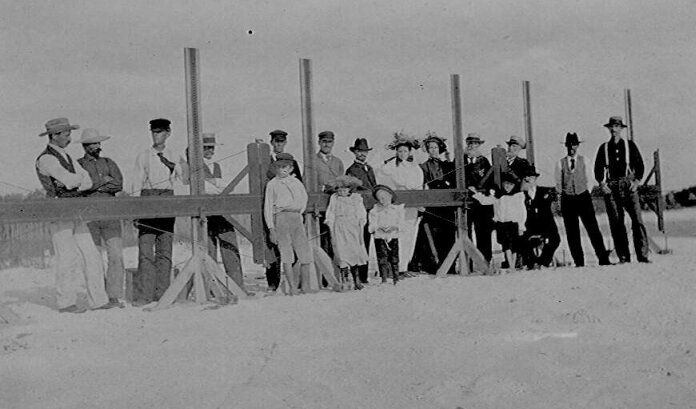 |
| Part of the land line assembled. Survey team and spectators pose
for the picture. Morrow is the short fellow in the black creased hat near the center. Photo: The Koreshan Historic Site. |
|---|
Morrow kept a notebook of data. Each measurement was checked by several persons and initialed by them. Morrow said he "directed and tested every Adjustment and Measurement of the entire Survey, and personally checked same in Record Books." These record books may have survived, and may reside in the un-catalogued archive materials at the Koreshan Unity Foundation Museum and Library, but have not been located at the time of this writing. We do have a very full account of procedures, and a table of data every 1/8 mile, in Part II of Teed's Cellular Cosmogony, written by Morrow. This includes data from the spirit level, the mercury level, horizon sighting, the plumb bob, and, of course, the elevation of the rectilinear line above mean water level.
A systematic error?
All of these suggest that the error is not in the water level measurements, nor in the actual shape of the water surface, nor in tidal variations (which were taken into account properly). If an error is present, it is in the actual rectilineator, or in the procedure of positioning and securing the rectilineator segments.
Calculated
Date Dist. Height Height ratio of Radius Dev.
1897 (miles) above below curvature (miles) %
datum 2nd (inches)
(inches) datum (in)
Mar 18 0.000 128.000 0.000
19 0.125 127.850 0.150 0.020 3300.0 -18.5
23 0.250 127.740 0.260 -0.352 7615.4 88.0
24 0.375 126.625 1.375 0.568 3240.0 -20.0
25 0.500 126.125 1.875 0.625 4224.0 4.3
27 0.625 124.125 3.875 2.650 3193.5 -21.2
30 0.750 123.675 4.325 3.048 4120.2 1.7
31 0.875 121.570 6.430 4.583 3772.2 -6.9
Apr 1 1.000 119.980 8.020 6.172 3950.1 -2.5
2 1.125 117.875 10.125 8.355 3960.0 -2.2
8 1.250 116.440 11.560 9.468 4282.0 5.7
9 1.375 113.690 14.310 11.625 4185.5 3.3
13 1.500 111.070 16.930 13.680 4210.3 3.9
14 1.625 107.190 20.810 17.620 4019.9 -0.8
14 1.750 104.690 23.310 20.560 4162.2 2.8
15 1.875 101.690 26.310 22.655 4233.2 4.5
16 2.000 97.380 30.620 26.495 4138.5 2.2
24 2.125 93.440 34.560 28.530 4139.3 2.2
26 2.250 85.320 42.680 35.835 3757.7 -7.2
27 2.375 79.750 48.250 42.590 3703.5 -8.6
May 8 2.500 74.000 54.000 48.125 3666.7 -9.5
8 2.625 68.000 60.000 54.500 3638.3 -10.2
8 2.750 63.000 65.000 95.000 3685.8 -9.0
.
8 3.000 53.000 75.000 3801.6 -6.1
....
8 4.125 0 128.000 4211.4 4.0
earth's radius, averaged from 1/8 mile curvatures: 4050.5 mile
Average deviation of data values from the mean: 10.2 %
Average deviation of the mean: 2.1 %
Modern value of earth's radius: 3963.5
Discrepancy: 2.2 %
|
|
Ulysses G. Morrow's Naples Survey Data. The first four columns are from The Cellular Cosmogony (1898). The last three columns, and the summary results below, have been added, newly computed from the Morrow data. |
|---|
These five independent measures are consistent, within the expected measurement errors. They show the expected decrease of height, the expected shift of the plumb line southward, the expected movement of the spirit level bubble northward. These measures changed slowly during the first mile, and changed more rapidly the farther south the line extended. All these are consistent with the assumption of a convex earth.
Even more remarkable is the fact that the results were consistent with an earth circumference of 25,000 miles. Looking at the data with more modern techniques of data analysis than the Morrow team used, the data show that value to have an experimental uncertainty of a bit over 2%. It differs from the modern value by only about 2% also.
The fact that the average of the signed deviations is so small indicates that the individual values fluctuate about equally above and below the mean. This is an indication that the data is reasonably normal, and the distribution of random errors isn't skewed. While the individual values fluctuate about 10% from the mean, the average deviation of the mean is only about 2%, benefiting from the process of averaging 24 values. This "average deviation" measure is comparable, as a measure of "goodness of the result, to the standard deviation of the mean, a measure more commonly seen in research papers today.
So far, looking only at the data, this would seem to be a good experiment, with measurement uncertainties consistent with the instruments and methods used. But there's that nagging sign of the curvature: concave instead of convex. And that makes a huge difference. If the sign is negative, it effectively turns the whole universe inside-out.
Scientists, and especially students, know the frustration of trying to find the source of a "sign error" in a complicated mathematical derivation, or in the analysis of an experiment. This Naples experiment presents just such a challenge, complicated by the fact that now, over a century since it was carried out, it is a very "cold case".
The Koreshans fully expected the value of 25,000 miles, in agreement with that of conventional geodesy. Why? One conventional way to measure the curvature of a land surface is to use sighting instruments between points in a net of triangles. A large net of this sort can distinguish between a flat and a curved surface, and can measure the radius of a spherical surface. But it cannot determine the sign of curvature. The triangle net would have the same structure and angles on the outside surface of a sphere as it would on the inside surface of the same radius sphere. Thus Morrow could generally accept the results made by geodesists of many countries using these methods. But he simply disagreed on the sign of the curvature.
So, if we think the result is in error, what caused that error? If the error isn't a result of cumulative "random" error, it must be due to a systematic (consistently repeated) error of measurement or procedure.
This motivates us to look again at the rectilineator itself. Morrow assumed that it was a rigid body that simulated a perfect rectangle, and when adjusted to that condition, it remained in that condition throughout the experiment. A casual look at it gives the impression that it was designed for maintaining its geometry. Those steel cross braces look as if they were intended to provide rigidity and preserve that geometry.
Morrow says that the purpose of the steel rods was to allow initial adjustment of parallelism of the 4 foot cross beams at the ends of the rectilineator. In fact, adjustment of the rods will alter that condition by small amounts and allow one to achieve a high degree of parallelism initially. The rod tension acts against the tension in the mahogany structure. The rectilineator sections were flipped top/bottom each time they were reused, which might be expected to average out any slight and unnoticed lack of parallelism over the whole span of 1045 sections. This seems to be good experimental procedure.
The rectilineator isn't as rigid as it looks.
But there's no such thing as a perfectly rigid body. Bodies flex and warp under load, even under the load of their own weight. A horizontal beam suspended or supported at its center will bend so that the ends droop downward. This can be minimized by suspending or supporting the beam at two points, carefully located. Even then the beam bends somewhat, but in a way that doesn't affect the parallelism at each end. Knowing the materials and the dimensions of the parts, these points can be calculated precisely. Was that done? Morrow doesn't say.
|
The rectilineator sections were supported by standards (vertical support piers) at two points. Photographs and drawings show the standards in place, and they are consistently placed. And they are wrong. Calculation made from the photos, and from Morrow's drawings, shows that the points are both about 2.6 inches too close to the center of the rectilineator. This would allow the ends to sag downward.
The support points the Morrow team used would have been very close to the correct points if the four 45 degree wooden braces weren't present. Those braces make the ends heavier. One might wonder whether those braces were an afterthought, after the experimental design had been completed. But that can only be speculation without more information than we have in hand.
What about the initial carefully-established parallelism of the cross beams? Those steel cross rods do not connect to each other where they cross, and are secured to the wood center beam with 8 short wood screws no longer than 3/4 inch! Such a structure will be no more rigid than if the rods weren't there. In fact, if the main beam bends, the cross beams will move out of parallelism and the rods won't prevent that, because the rods will go slack.
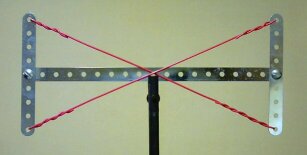 |
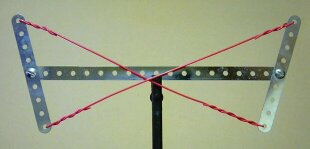 |
| Ends aligned. | Cross rods go slack as ends are misaligned. |
|---|
These photos of a scale model rectilineator show that the cross rods do not contribute to rigidity. The end cross beams easily move out of alignment, and the more they depart from parallelism, the slacker the rods become.
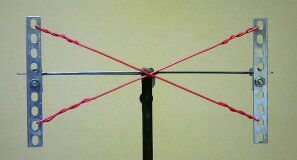 |
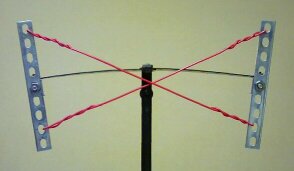 |
| Rigid beam. Ends aligned. | Flexible beam bends under its own weight. Ends are misaligned. |
|---|
This model is a better simulation of the Morrow rectilineator. In the first photo the horizontal beam is made rigid with a steel strip bolted to it. In the second photo nothing is changed except that the steel strip has been removed, and the thin plastic horizontal plate allowed to sag. The cross braces go slack again.
|
The initial adjustments for parallelism were apparently made with the rectilineator lying in a horizontal plane. So as soon as the rectilineator was positioned in a vertical plane, it lost its parallelism because of bending under the force due to gravity.
Even if the rectilineator had been designed properly, and as rigid as good engineering design would allow, the structure would still not be perfectly rigid. The error in the support point locations would still result in the ends sagging downward. But the fact that the rectilineator design allows unnecessary non-rigidity suggests that Morrow and his team did not consider rigidity an issue. Nowhere in the available accounts is this mentioned as a possible source of error to be dealt with. Nor did critics of the experiment suggest that possibility.
Inverting the rectilineator section top/bottom doesn't help either, for the structure will still flex in the same sense, with it ends drooping. Could this be the systematic error that accounts for the results? With the materials used in the rectilineator, the amount of flexure of the rectilineator can't be very large. But a warp of only 0.000003 degree in each section, multiplied by the 1045 sections in a four mile length, gives a cumulative error of 0.003 degree. That would be about the latitude difference between the endpoints of the survey. Such a small error was far too small to be measured or detected in just one, or even a string of a few, rectilineator sections. In fact Morrow's own data table, reproduced below, shows measurements to only three to five significant figures.
This is a subtle source of systematic error. The preliminary tests of the rectilineator were done with only a few of those sections (they had four). The systematic error for these would be far beneath detection level during those tests. An individual section's cross arms might deviate from parallelism in one of two directions, or might, by sheer accident be nearly parallel for one orientation of the rectilinator. If it deviated in either direction, then when the section was inverted, the deviation would flip to the other direction and still be such as to cause the ends to bend downward. Even if by pure accident the first few rectilineator sections were aligned exactly parallel, the procedure of "recycling" sections and inverting them would ensure a systematic error from that point onward of about the same amount over the entire length of the survey.
The procedure of inverting the sections guaranteed that any small initial systematic error would propagate to cause significant error in the results. If the cross arms had accidentally been initially perfectly parallel for all sections (a very unlikely situation) and the sections had not been inverted, then no systematic error due to bending would have been seen over the full length of the survey. If there were an initial error of leveling, and the sections had not been inverted, the systematic error could have given results showing either positive or negative curvature of the earth, with equal likelihood, and of size that could have ranged from zero to the value reported, or even more. The seemingly sensible systematic procedure of inverting sections when they were reused doomed this experiment to success, at least success as the Morrow team saw it.
Systematic error would automatically result in excellent agreement between the measuring instruments. They would all agree, all the way along the line. As the line progressed southward, the plumb bob on the end of the cross arm would deflect southward, the bubble on the spirit level would move northward, just as Morrow observed. All of these measures depend directly on the actual downward arc of the rectilineator land line. The horizon sightings would reflect this also. But during all this time the experimenters thought the land line was straight, and the earth curving upward, when in fact the earth curved downward and the rectilineator land line curved downward even more.
Expectation bias?
|
But this seems too easy a solution. Surely it stretches credibility that the bending of the rectilineator would be just right to give a result of size within 2% of the expected value. By "expected" I mean the value of earth radius that the experimenters expected. And that may be the key word here. Expectation bias could have played an important role. {2}
Morrow notes that in the first 1/4 mile the changes in all data readings showed no clear evidence of curvature. This was no surprise, for the expected curvature was smaller than random instrumental errors. But by the end of the first mile the curvature was clearly shown, and it was in the expected direction.
Morrow had previously calculated a table of numbers indicating what data should result for (1) a concave earth, and (2) a convex earth. When the numbers began showing curvature in the direction supporting the concave earth hypothesis, the entire team must have been encouraged and elated. Still, measured values weren't perfectly in agreement with expectations. Morrow wouldn't have been much concerned about that, attributing it to the expected random errors of individual measurements. This would work itself out as the rectilineator line became longer. Perhaps it did.
I think it highly significant that when Morrow calculated that table of expected measurements for a concave earth surface, he calculated it for a curvature that would give the earth a circumference of 25,000 miles. His final reported results confirmed that, giving the earth's radius as 4050.5 miles. This is only 2.2% from the modern value of the earth's radius: 3963.5 miles. So far as I know Morrow never reported this result, but it is easily calculated from his data (see below). This is one reason some critics are convinced that Morrow faked the whole experiment. Why should Morrow have expected in advance that that particular value of radius should be the outcome of his experiment? It was, after all, previously calculated on the conventional model of the earth as a convex sphere. Why should the vastly different concave sphere earth model yield the same conclusion? Morrow never explains that.
Now we can imagine the team continually checking heights above water level, plumb line and elevation, as the survey preceded southward. Each time a new 12 foot section of rectilineator was positioned, these were compared against the precalculated tables. Each measurement was made to the limits imposed by the instrument scales, and involved some judgment. Under these conditions there's a distinct possibility of unconscious bias to make each measurement agree more closely with expectations. It wouldn't take much "correction" each time. These measurements and adjustments were made every 12 feet for nearly 4 miles. That's nearly 1760 sets of measurements. In this way the experimenter's expectation bias can introduce a systematic error. Each measurement is biased just a bit in the direction of better, but not necessarily perfect, agreement with the precalculated values. [The published data tables show values only every 1/8 mile, over most of the 4 mile distance, a total of only 25 values.]
Nowadays we are more sensitive to the importance of avoiding the possibility of such errors. Experiments where such bias is possible are designed to be blind and double blind. In this case, the rectilineator positioning, manipulation, and measurements should have been done by people who had no idea what the expected outcome was. But even more important here, the design of the rectilineator and its initial adjustments should have been subject to independent and competent scrutiny. The persons making the measurements should never have had access to the previously calculated values expected for a concave earth, convex earth, or flat earth.
I have presented a plausible hypothesis explaining how a systematic error in the rectilineator design itself (allowing bending), a blunder in calculating the two support points, combined with a systematic error due to expectation bias, could easily account for the published results of the Naples Experiment. But because the case is so old, and the original sources we might like to examine are just not available, we may never be able to declare that all the "loose ends" of this experiment have been tied.
However, this analysis clearly establishes that the method of the experiment was flawed. Its assumption of perfectly rigid rectilineator sections cannot be supported. It ignored the possible propagation of a very small determinate error, easily capable of accounting for the result the Morrow team observed.
Was this experiment doomed to failure?
But there's another interesting aspect to this. From what Teed and Morrow have written, we see no indication that they ever worked out the full mathematics of the Cellular Cosmogony, but concentrated on qualitative descriptions. They may have understood that their model of the universe required that the speed and direction of propagation of light both must change drastically with distance from its center, but had no motivation (or ability) to get mathematical about it. Morrow's writings don't indicate that he dealt with the mathematics of the Koreshan model. Morrow's interest was focused only on the surface of the earth.
Even today we see small groups around the world who still advocate models evolved from Teed's Cellular Cosmogony. How does such a hollow earth idea survive today, in the era of space travel? The Koreshans didn't have to deal with explanations of anything from earth venturing far from their rock shell. They didn't have to sweat the mathematical details of variations of speed of light with distance from earth. The Koreshans could describe the Moon as an illusion caused by focalization of light. Today men have walked on the Moon, and the "illusion" idea doesn't survive, unless, like the modern flat-earthers, we assume that the entire space program is a giant conspiracy to deny the truth, faked on a Hollywood sound stage with clever special effects.
While most hollow earth promoters aren't capable of doing mathematics or physics, a few have at least looked at the mathematics. They make mathematical models of the universe based on a transformation of R to 1/R where R is the distance from the center of the earth (on the conventional view). In 1983 mathematician Mostafa Abdelkader published a paper in which he worked out the mathematical consequences of this. He concludes that there's no way to distinguish between this model and the conventional model—no way to tell if the universe is the way you learned it in school, or whether it is inside-out. He does conclude his paper by saying he favors the inside-out view. [6]
This is mathematically justified, and reminds us that mathematical models are our own invention to describe what we observe in nature, and sometimes several vastly different-appearing models can equally well do the job. But, accepting this, we must realize that this mathematical reconfiguring of the space metric works near the earth's surface also, so the Naples experiment would be doomed to failure even if everything had been done perfectly. Not just light paths are warped in this model, but so are angles. Physically "straight" rulers are warped also and we wouldn't know it. Even worse, you could have a 1/R2 remapping, or any other consistent mathematical transformation, and you still couldn't distinguish one model from another by any clever experiment you might devise. [7]
Several websites promote variations of this idea. Two distinct versions are seen:
- The strict mathematical remapping of the geometry. These folks admit
there's no experiment that one could devise to distinguish one model
from another. None have taken on the formidable task of mathematically
transforming physics, only the geometry. Therefore they tout their
preferred model as being simpler and therefore better.
Any such model may seem simpler if you do only the easy part of the transformations! The fact is that they are simply not capable of reworking the physics that would support their hypothesis.
- Others don't accept, or even understand, the indistinguishability of transformed models, and still cite long-discredited "evidences" for their model, such as the Naples Geodetic Survey, the Tamarack Mines Diverging Plumb Lines, radio trasmissions to any point on earth, etc. Some even hope to undertake their own experiments to determine the curvature of the earth, but are ill-equipped to design an experiment properly, or interpret its results.
Some of these folks seem to be motivated by religious beliefs, attempting to make the model consistent with their interpretations of their sacred literature. Some are motivated by a distrust and dislike of science. Many feel that science has become just too difficult for people to grasp, so there must be a simpler way to understand it. A few have even majored in a science at the university for a while, but dropped out because they found it distasteful. All are sustained by a monumental self-confidence in the "rightness" of their world-view. They comfortably accept the notion that scientists are part of a vast conspiracy to suppresss the truth, in order to maintain their own positions of power and prestige.
Like pseudoscientists of all varieties, they carefully select those aspects of experience they wish to incorporate into their model, ignoring the vast amount of other scientific phenomena that conventional science has already successfully dealt with. They cite old, discredited, or poorly documented, observations, experiments and theories that seem supportive of their views. They misinterpret and misrepresent sources to fit their beliefs. Often they wage a guerrilla war against "conventional science", and characterize scientists as imperceptive or even stupid for not acknowledging their cleverness and the truth of their alternative models. They imagine themselves a member of a select few, the elite, who can see things clearly, things that highly educated and experienced scientists are "too blind" to see.
Updates, July 2015.
I've been criticized for not mentioning that Morrow checked his data by extending the rectilineator line backward from the last position, back toward the starting point, and this recreated the curvature nearly exactly. This was reported only between mile markers 2 3/8 and 2 in the The Cellular Cosmogony. I naively assumed that it would be obvious to the reader that such an exercise would demonstrate nothing more than the fact that this "return survey" followed the same procedure as the forward survey. Apparently this was not so obvious to some.Consider the forward survey's last rectilineator position. Now for the return survey, this section is left in place (already tilted downward toward the earth at the far end) and the other sections are then fastened in turn to it. If they flex consistently as in the forward measurements, the reconstructed backward measurements will duplicate the curved path of the forward measurements. The return survey only demonstrates that the measurementes were performed in the same manner both forward and backward, with the same procedures and consistently flexing apparatus.
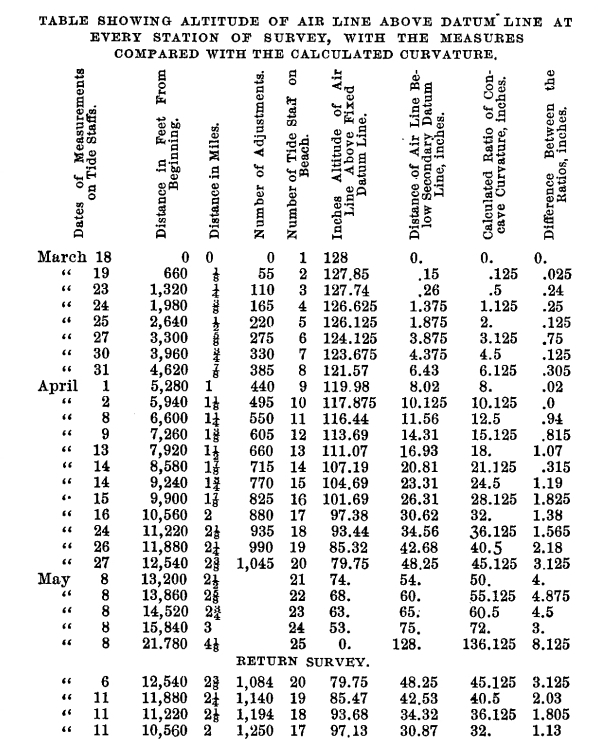 |
I've also been criticized for not emphasizing that a committee was always present to ensure that the measurements were correctly made, with no cheating or data fudging. However I did make clear that the results were mainly due to the non-rigidity of the rectilineator sections. One reader (an engineer) reminded me that the amount of flexure of such a limp structure depends on the placement of the two vertical standards (supports) of each rectilineator section. Was Morrow aware of this, and did he calculate the proper placement of the supports that might ensure parallelism of the ends of each section? He doesn't address this issue at all. His procedure of inverting each section does not correct this possibility. My correspondent suggests that Morrow might have deliberately chosen the placement of the standards to ensure the desired result—concave water surface of the desired amount. This is, of course, speculation, but it would be an ingeniously clever way to deceive the observing committee, for all the tedious positioning of apparatus and the careful and precise measurements would then be honestly made, and only a very astute committee member would question the apparatus itself.
But I think the most fundamental criticism, from a physics student, has to do with something every physics and engineering student is supposed to learn and use in all laboratory experiments: analysis of uncertainties (error analysis). This mathematical procedure shows how uncertainties in the data propagate to cause uncertainty of the resuslts. This whole Naples experiment hinges on the assumption that the initial rectilinator position is exactly positioned relative to the water surface, as measured by the spirit level, mercury level and the plumb line. These measurements should be consistent, but they have limited precision. Any slight error in the placement of the initial 12 foot long section will propagate as other sections are successively attached and relocated. There's no way the final result, over four miles, could have the precision claimed. This strongly argues that something was fudged.
This also answers the question "Why has this experiment never been repeated by skeptics?" One reason is that they know that it is a poorly designed experiment even if executed honestly. It might be interesting as a student project to build one rectilineator section exactly as Morrow did, and then test its rigidity and the amount of flexure as a function of the position of the two standards (supports), and also how it behaves when inverted.
But the whole business seems futile in the light of the Koreshan's fundamental notion that the geometry of the entire universe is warped in such a way that we have been deceived about it's "actual" construction. If that were so, the physical equipment used in the Naples experiment, the rectilinator, rulers, etc.) would also have been subject to this warping, and the experiment would prove nothing. In fact, there's no conceivable way we could establish a reference line guaranteed to be "straight", independent of this universal space warping.
I've also been asked about the justification for the title "Professor" that Morrow used. he had once been principal of The Corning School of Shorthand in Corning, Iowa, and in 1888 published a book "Phonography" a textbook on his system of phonetic shorthand. He had no earned degree in anything, certainly not geodessy, but was apparently well read in techniques of surveying. It is also noteworthy that only one member of the observing committee had a college degree—in literature.
 |
Some have inquired where one can see historical remains of the Koreshan community. There's a Koreshan Historic Site and state park near Estero, Florida, with restored buildings of the original Koreshan Unity. Across the road is the Koreshan Unity Foundation Library and Museum, the only remaining part of the Koreshan Unity, which still owns some land there. See the picture below, taken in 1984. Admission is free, by appointment only.
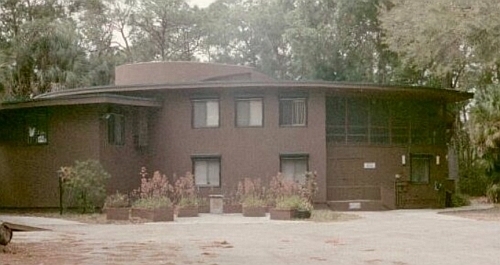 |
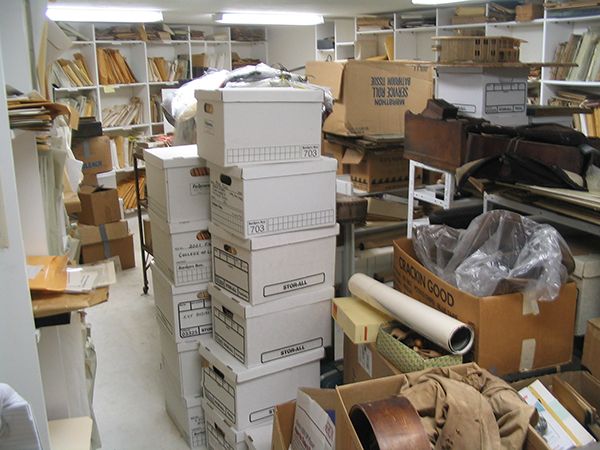 |
| The Khoreshan Foundation Archive in 2001. |
|---|
Update, 2020.
The Koreshan Unity Foundation has abandoned its museum building in Estero. It is up for sale. This newspaper report explains the reasons. College of Life Foundation changing direction. When I visited it in 1984 and 2001 I was unimpressed with the Foundation's commitment to its historical archives. The museum could only be visited by appointment. It had some Koreshan artifacts on display, some old books, mostly the sort one would find in a public library in the late 1800s. There were some copies of Koreshan publications, some poorly printed postcards for sale depicting the early history of the Koreshan Unity, and copies of The Cellular Cosmology for sale. I was allowed to look through some albums of old photos. I asked about whether they had any of Morrow's original notes and papers, or his notebook on his experiments. I was told they weren't aware of any, but some might be in the archives. The archives were not catalogued and not accessible. I was allowed to look into the storage room containing the archived material. It was a small room with boxes and piles of materials in disarray. No one had even made an inventory! I took a photo of that room, but was not allowed to access anything. Where would I have begun!
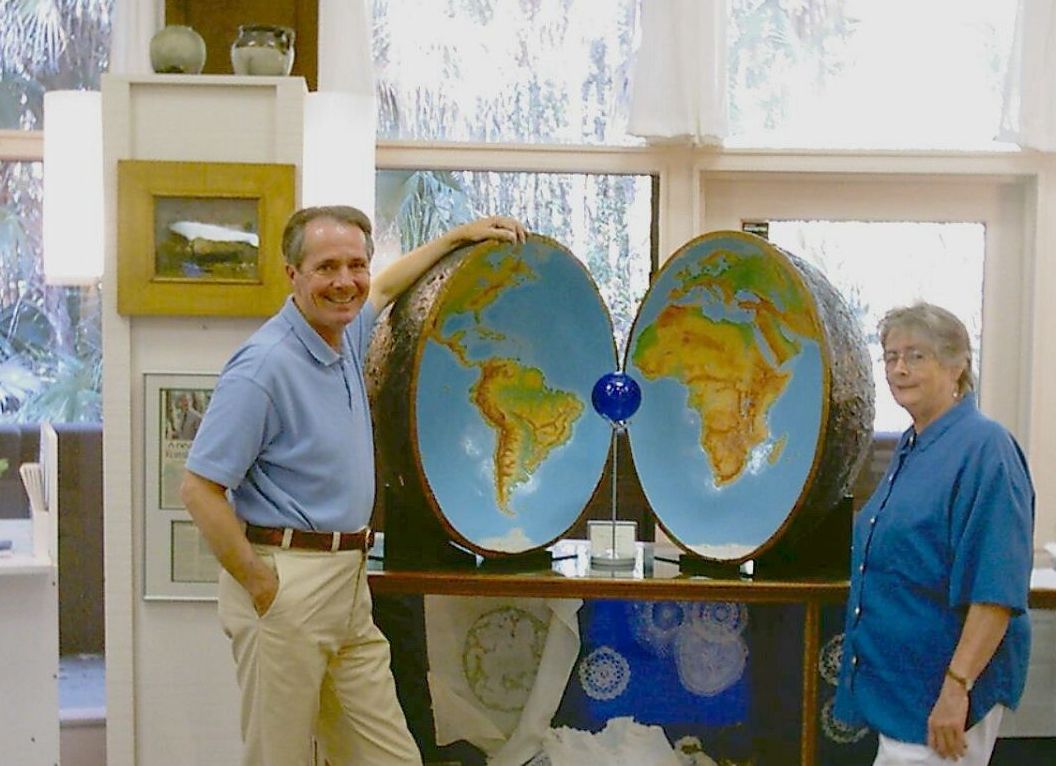 |
| The hollow earth globe. Charles Douray and Sarah Berquist in 2001. |
|---|
I did photograph the large hollow earth globe, a gift to the museum from a hollow earth group in Norway. The photo shows the foundation director Charles Douray and Sarah Berquist. I had lunch with them. Douray seemed to have absolutely no interest in the history of the Koreshan Community, but regaled me with his plans and maps for developing nearby land owned by the foundation as luxury housing, shopping centers and other commercial projects. He seemed more like a used-car salesman than a museum director.
What happend to that pile of archive materials? It seems to have been shipped to a warehouse that the foundation owns in Tenessee. This is how history is lost.
Endnotes:
Endnotes in the text are in curly brackets.
- If anyone has access to a copy of this, please get in touch.
- I thought I'd invented the term "expectation bias" and that it's
meaning was self-evident. But I'm informed it is used in medical research,
mathematical statistics and other fields, and there seem to be several
kinds of expectation bias, including:
- The experimenter's expectations bias the data-taking procedure itself, causing recorded data to be biased toward the results expected.
- The experimenter's judgment of observations is biased by the experimenter's prior knowledge and interpretation of other related facts. Example: a judgment made from a diagnostic tool, such as an X-ray, is biased by knowing the patient's medical history and symptoms. The procedure is not "blinded" as it should be for research purposes.
- The experimenter's expectations affect the way data is interpreted. The data itself may be unbiased.
- The experimenter sees only experimental observations that support preconceived expectations, ignoring all other observations. This is called "cherry-picking".
References:
References in the text are in square brackets.
- Halley, Edmond, An account of the cause of the change of the variation of the magnetical needle with an hypothesis of the structure of the internal parts of the earth: as it was proposed to the Royal Society in one of their later meetings. Philosophical Transactions of the Royal Society of London 17:563-578.
- Morrow, Ulysses G., ed. The Flaming Sword & The Salvator and the Scientist. Guiding Star Publishing House. (Volume 1, 1896 - Volume 11 (1987).
- Sherman, M. L, and William F Lyon. The Hollow Globe: Or, The World's Agitator And Reconciler. A Treatise On the Physical Conformation of the Earth. Chicago: Religio-philosophical Publishing House, 1871. Reprint copies of this dreary book are widely available. It can be read for free at the Making of America archive.
- Teed, Cyrus R. The Cellular Cosmogony or The earth a Concave Sphere. The Guiding Star Publishing House, Chicago, 1898, 1905. Reprinted by Porcupine Press, 1975.
- Teed, Cyrus R. The Cellular Cosmogony or The earth a Concave Sphere. The Koreshan Unity, Inc., © 1922, 1951, 1983.
- Teed, Cyrus R. (Koresh) Fundamentals of Koreshan Universology. The Guiding Star Publishing House, Estero - Florida, 1927.
- Schadewald, Robert. "He knew earth is round, but his proof fell flat". Smithsonian, April 1978, pp. 101-113.
- Abdelkader, Mostafa A. "Mapping Outer Space Into a Hollow earth". Speculations in Science and Technology, 6, 1983, pp. 81- 89.
- Gardner, Martin. "Occam's Razor and the Nutshell earth". The Skeptical Inquirer, 12, Summer 1988, pp. 355-358. This is reprinted in Gardner's book On the Wild Side.
- Kafton-Minkel, Walter. Subterranean Worlds: 100,000 years of dragons, dwarfs, the dead, lost races & UFOs from inside the earth. Loompanics Unlimited, 1989.
- Ohnemus, Catherine A. Anthony. Dr. Cyrus Teed and the Koreshan Unity Movement.
- Freitag, Ruth S. Hollow earth Theories: a list of references.
- Standish, David. Hollow earth The long and curious history if imagining strange lands, fantastical creatures, advanced civilizations and marvelous machines below the earh's surface. da Capo Press, 2006.
A number of generous persons provided information, photographs and documents used in preparation of this document. They are not, however, responsible for any interpretations I have drawn from them.
- Catherine Ohnemus, Peter Hicks, Nancy Kilmartin, and the rest of the gang at the Koreshan State Historic Site.
- Sarah Berquist and Charles Douray of the Koreshan Unity Foundation Library.
- Lorraine N. Norman provided useful information about her grandfather, Ulysses G. Morrow.
- Dr. G. Slade Gargill III commented on fine points of materials science and engineering.
- Schadewald and Simanek. Timeline of U. G. Morrow, showing his
evolution from a flat earther to a hollow earther.
|
|
This document, ©2003, 2015 and 2020 by Donald E. Simanek. Comments are welcome. Use the address to the right. When responding, please indicate the specific document title or URL.
Return to Myths and Mysteries of Science.
Check out an alternative theory, The Flat earth.
Return to Donald Simanek's front page.


